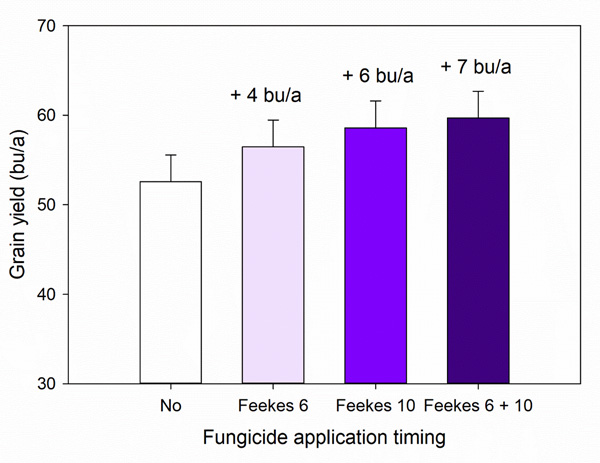Wheat is greening up across Kansas and producers are preparing to topdress nitrogen or apply herbicides. We commonly receive questions about the value of including a fungicide in the mix with those applications. This can be an economical option, but there are a few things to remember.
Research at K-State and in other regions continues to demonstrate that fungicides applied between flag leaf emergence and heading growth stages provide the largest level of yield protection against foliar diseases. The yield response to this later fungicide application is influenced by the level of disease risk (amount of disease and predicted weather conditions), variety resistance to the most threatening fungal diseases, crop yield potential, foliar fungicide efficacy, and other factors.
Fungicides can also be applied as an early application made between “spring green-up” and jointing. This application may provide some yield benefits in some fields and years but often doesn’t achieve the same level of yield protection as post-flag leaf emergence applications. Early fungicide applications may result in a yield advantage due to a reduction in early disease establishment in the lower canopy. This may be particularly true for “leaf spot diseases” such as tan spot or Septoria leaf blotch that survive in wheat residue and can establish early in the year. Yield benefits are most likely in wheat fields planted back into wheat stubble and when weather conditions are wet enough to favor fungal disease development. There can also be some rust suppression with early applications, particularly when disease levels are high later in the season (Figure 1). The challenge is that it is difficult to know if rust disease will be a threat during these early growth stages.

Figure 1. Yield benefit of Feekes 6 (first node visible) solo application, Feekes 10 (boot) application, and a two-application program. Data represents the average of 20 trials conducted under naturally occurring disease pressure.
If you decide to make an early application, it is important to factor that into the full-season fungicide program. Many active ingredients have use restrictions, where a limited amount of an active ingredient can be applied during a single season. It is important to ensure that early fungicides do not limit options for fungicide applications at flag leaf (which have the potential for higher yield protection in conducive disease years). Some fungicides have special “2ee” labels that allow for lower-rate applications early in the season for winter wheat. Double-checking labels when choosing a fungicide product is always a good idea.
Since the payoff for an early application is less certain than with later applications, it is perhaps best to consider using a low-cost fungicide for the early application and saving more expensive products, if desired, for the later application.
Producers considering the use of split applications must pay close attention to label restrictions. Every active ingredient in a fungicide has a maximum total amount that can be applied during the season.
For example, if an early application of a generic form of tebuconazole is applied at 4 oz/acre, a subsequent application of any fungicide containing tebuconazole alone or in combination with other ingredients (e.g., premix) around heading could put you over the limit for the crop season. Thus, be sure to read the label to determine the maximum amount of a chemical that can be applied in a single season and the exact amount of a chemical(s) that is in a fungicide.
For information on the efficacy of different foliar fungicide products, refer to the K-State Research and Extension publication Foliar Fungicide Efficacy Ratings for Wheat Disease Management 2024, EP130.
Conclusions
The main conclusions we can draw from recent studies in Kansas:
- In K-State studies, the greatest average profit has come from the flag leaf application of fungicides. Fungicides applied prior to or around jointing can provide some yield benefit when disease is present, but they do not provide as much protection as a flag leaf application.
- The likelihood of profit for an early-season fungicide application is greatest for susceptible varieties in continuous wheat systems with a high level of surface wheat residue.
- Fields with hot spots of tan spot, septoria leaf blotch, and stripe rust prior to flag leaf emergence are candidates for an early fungicide application, provided environmental conditions are conducive for further disease development and crop yield potential. These applications are often most effective when made around the jointing stages of growth.
Additional resources
KSRE publication Foliar Fungicide Efficacy Ratings for Wheat Disease Management 2024.
For information on assessing the need for wheat foliar fungicide, refer to the KSRE publication Evaluating the Need for Wheat Foliar Fungicides, MF3057.
Another publication providing good information, from which a few excerpts were used in this article, is Oklahoma State University’s Split Versus Single Applications of Fungicides to Control Foliar Wheat Diseases, PSS-2138.
Kelsey Andersen Onofre, Extension Plant Pathologist
andersenk@ksu.edu
Romulo Lollato, Wheat and Forages Specialist
lollato@ksu.edu
Tags: disease wheat fungicide split fungicide